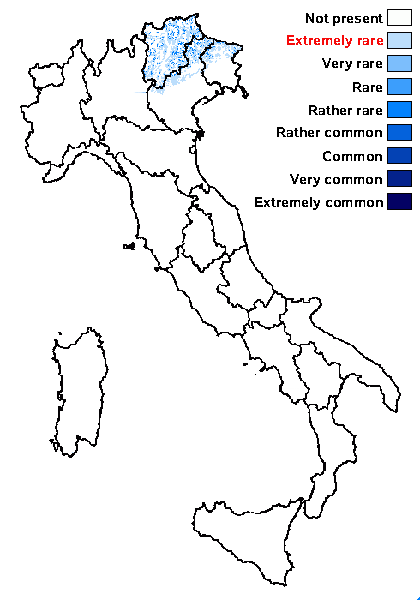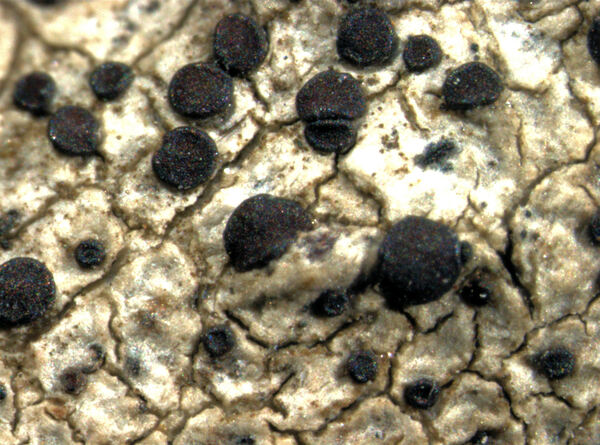Lecidea rhododendri (Hepp) Zahlbr.
Ann. naturhist. Hofsmus. Wien, 15: 183, 1900. Basionym: Biatora sylvana var. rhododendri Hepp - Flecht. Eur.: 733, 1867.
Synonyms: Biatora rhododendri (Hepp) Arnold
Distribution: N - Frl (Hinteregger 1994), Ven (Nascimbene & Caniglia 2000, 2003c, Tomaselli & al. 2006), TAA (Nascimbene & al. 2007b).
Description: Thallus crustose, thinly episubstratic, yellowish white, greenish white or very pale brown, continuous and smooth to weakly areolate, the areoles 0.25-0.5 mm wide, without a distinct prothallus. Apothecia biatorine, rounded to irregular by mutual compression, slightly constricted at base, 0.3-0.5 mm across, with a red-brown to finally black-brown, rarely orange-brown, concave to flat, finally convex disc and a clearly darker, red-brown to black, glossy, persistent but finally often excluded proper margin. Proper exciple of radially arranged hyphae with 1-1.5 µm wide lumina, the terminal cells to 5 µm wide, with brown-pigmented walls; epithecium reddish brown to brown-black, c. 10 µm high, without granules, K-; hymenium colourless, 40-70 µm high, I+ blue; paraphyses coherent, simple or sparingly branched in upper part, the apical cells 2-6 µm wide, surrounded by brown pigments which are insoluble in K and N; hypothecium colourless or pale yellowish, 60-80(-100) µm high. Asci 8-spored, clavate, with a K/I+ blue apical dome penetrated by a narrow, K/I– apical cushion surrounded by a narrow, deeply K/I+ blue zone, the wall K/I- but surrounded by an I+ red-brown, K/I+ blue outer layer, the ocular chamber relatively small, Biatora-type. Ascospores 1-celled (rarely a few 1-septate), hyaline, ellipsoid, (6-)7-11(-13) x (2.5-)3-4(-4.5) µm. Photobiont chlorococcoid. Spot tests: thallus K-, C-, KC-, P-. Chemistry: without lichen substances.Note: on twigs of Rhododendron and other subalpine shrubs; probably restricted to the Alps in Italy. According to Printzen (1995) this species does not belong to Biatora s.str. and is closely related to Lecidea erythrophaea; it does not belong to Lecidea s.str. either.
Growth form: Crustose
Substrata: bark
Photobiont: green algae other than Trentepohlia
Reproductive strategy: mainly sexual
Commonnes-rarity: (info)
Alpine belt: absent
Subalpine belt: rather rare
Oromediterranean belt: absent
Montane belt: extremely rare
Submediterranean belt: absent
Padanian area: absent
Humid submediterranean belt: absent
Humid mediterranean belt: absent
Dry mediterranean belt: absent

Predictive model
Growth form: Crustose
Substrata: bark
Photobiont: green algae other than Trentepohlia
Reproductive strategy: mainly sexual
Commonnes-rarity: (info)
Alpine belt: absent
Subalpine belt: rather rare
Oromediterranean belt: absent
Montane belt: extremely rare
Submediterranean belt: absent
Padanian area: absent
Humid submediterranean belt: absent
Humid mediterranean belt: absent
Dry mediterranean belt: absent

Predictive model
 INDEX FUNGORUM
INDEX FUNGORUM
 GBIF
GBIF
 DOLICHENS
DOLICHENS



